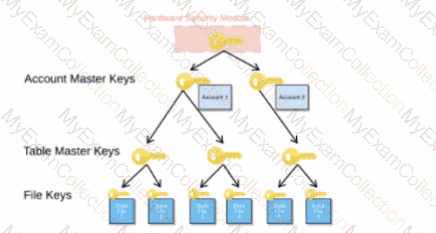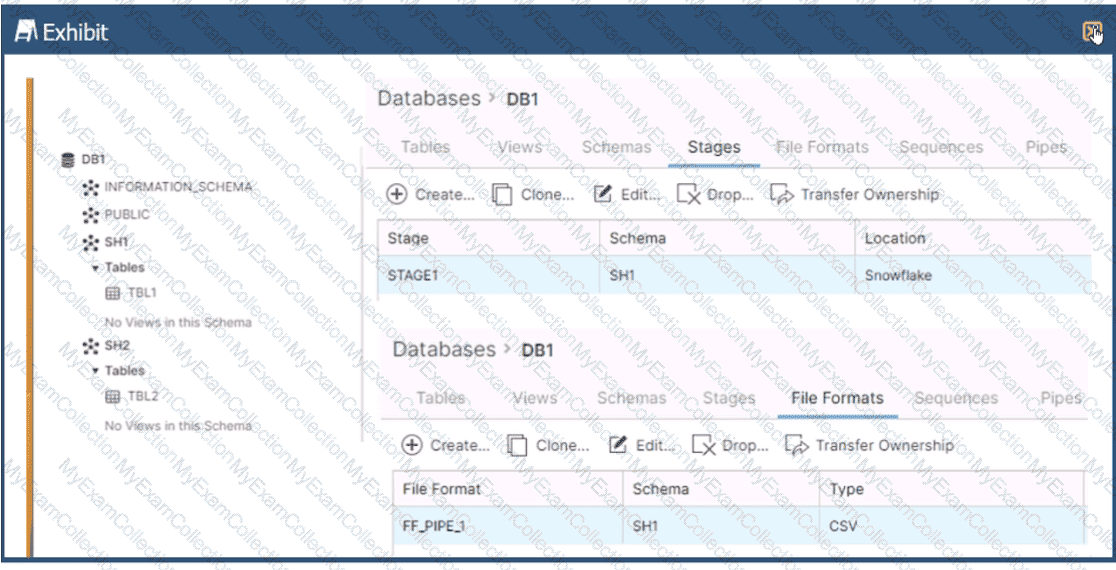Which Snowflake architecture recommendation needs multiple Snowflake accounts for implementation?
Consider the following scenario where a masking policy is applied on the CREDICARDND column of the CREDITCARDINFO table. The masking policy definition Is as follows:

Sample data for the CREDITCARDINFO table is as follows:
NAME EXPIRYDATE CREDITCARDNO
JOHN DOE 2022-07-23 4321 5678 9012 1234
if the Snowflake system rotes have not been granted any additional roles, what will be the result?
Which data models can be used when modeling tables in a Snowflake environment? (Select THREE).
At which object type level can the APPLY MASKING POLICY, APPLY ROW ACCESS POLICY and APPLY SESSION POLICY privileges be granted?
A retail company has over 3000 stores all using the same Point of Sale (POS) system. The company wants to deliver near real-time sales results to category managers. The stores operate in a variety of time zones and exhibit a dynamic range of transactions each minute, with some stores having higher sales volumes than others.
Sales results are provided in a uniform fashion using data engineered fields that will be calculated in a complex data pipeline. Calculations include exceptions, aggregations, and scoring using external functions interfaced to scoring algorithms. The source data for aggregations has over 100M rows.
Every minute, the POS sends all sales transactions files to a cloud storage location with a naming convention that includes store numbers and timestamps to identify the set of transactions contained in the files. The files are typically less than 10MB in size.
How can the near real-time results be provided to the category managers? (Select TWO).
An Architect needs to design a data unloading strategy for Snowflake, that will be used with the COPY INTO
Which configuration is valid?
Which technique will efficiently ingest and consume semi-structured data for Snowflake data lake workloads?
Company A would like to share data in Snowflake with Company B. Company B is not on the same cloud platform as Company A.
What is required to allow data sharing between these two companies?
Which of the following are characteristics of Snowflake’s parameter hierarchy?
An Architect would like to save quarter-end financial results for the previous six years.
Which Snowflake feature can the Architect use to accomplish this?
An Architect for a multi-national transportation company has a system that is used to check the weather conditions along vehicle routes. The data is provided to drivers.
The weather information is delivered regularly by a third-party company and this information is generated as JSON structure. Then the data is loaded into Snowflake in a column with a VARIANT data type. This
table is directly queried to deliver the statistics to the drivers with minimum time lapse.
A single entry includes (but is not limited to):
- Weather condition; cloudy, sunny, rainy, etc.
- Degree
- Longitude and latitude
- Timeframe
- Location address
- Wind
The table holds more than 10 years' worth of data in order to deliver the statistics from different years and locations. The amount of data on the table increases every day.
The drivers report that they are not receiving the weather statistics for their locations in time.
What can the Architect do to deliver the statistics to the drivers faster?
An Architect needs to improve the performance of reports that pull data from multiple Snowflake tables, join, and then aggregate the data. Users access the reports using several dashboards. There are performance issues on Monday mornings between 9:00am-11:00am when many users check the sales reports.
The size of the group has increased from 4 to 8 users. Waiting times to refresh the dashboards has increased significantly. Currently this workload is being served by a virtual warehouse with the following parameters:
AUTO-RESUME = TRUE AUTO_SUSPEND = 60 SIZE = Medium
What is the MOST cost-effective way to increase the availability of the reports?
A company needs to have the following features available in its Snowflake account:
1. Support for Multi-Factor Authentication (MFA)
2. A minimum of 2 months of Time Travel availability
3. Database replication in between different regions
4. Native support for JDBC and ODBC
5. Customer-managed encryption keys using Tri-Secret Secure
6. Support for Payment Card Industry Data Security Standards (PCI DSS)
In order to provide all the listed services, what is the MINIMUM Snowflake edition that should be selected during account creation?
A company is using a Snowflake account in Azure. The account has SAML SSO set up using ADFS as a SCIM identity provider. To validate Private Link connectivity, an Architect performed the following steps:
* Confirmed Private Link URLs are working by logging in with a username/password account
* Verified DNS resolution by running nslookups against Private Link URLs
* Validated connectivity using SnowCD
* Disabled public access using a network policy set to use the company’s IP address range
However, the following error message is received when using SSO to log into the company account:
IP XX.XXX.XX.XX is not allowed to access snowflake. Contact your local security administrator.
What steps should the Architect take to resolve this error and ensure that the account is accessed using only Private Link? (Choose two.)
An Architect needs to automate the daily Import of two files from an external stage into Snowflake. One file has Parquet-formatted data, the other has CSV-formatted data.
How should the data be joined and aggregated to produce a final result set?
When using the COPY INTO
command with the CSV file format, how does the MATCH_BY_COLUMN_NAME parameter behave?
Which of the following are characteristics of how row access policies can be applied to external tables? (Choose three.)
A company has a table with that has corrupted data, named Data. The company wants to recover the data as it was 5 minutes ago using cloning and Time Travel.
What command will accomplish this?
What integration object should be used to place restrictions on where data may be exported?
A Snowflake Architect is designing a multi-tenant application strategy for an organization in the Snowflake Data Cloud and is considering using an Account Per Tenant strategy.
Which requirements will be addressed with this approach? (Choose two.)
An Architect needs to allow a user to create a database from an inbound share.
To meet this requirement, the user’s role must have which privileges? (Choose two.)
A Snowflake Architect is designing a multiple-account design strategy.
This strategy will be MOST cost-effective with which scenarios? (Select TWO).
A user is executing the following command sequentially within a timeframe of 10 minutes from start to finish:

What would be the output of this query?
Which command will create a schema without Fail-safe and will restrict object owners from passing on access to other users?
When activating Tri-Secret Secure in a hierarchical encryption model in a Snowflake account, at what level is the customer-managed key used?

An Architect is troubleshooting a query with poor performance using the QUERY function. The Architect observes that the COMPILATION_TIME Is greater than the EXECUTION_TIME.
What is the reason for this?
What does a Snowflake Architect need to consider when implementing a Snowflake Connector for Kafka?
An Architect is troubleshooting a query with poor performance using the QUERY_HIST0RY function. The Architect observes that the COMPILATIONJHME is greater than the EXECUTIONJTIME.
What is the reason for this?
You are a snowflake architect in an organization. The business team came to to deploy an use case which requires you to load some data which they can visualize through tableau. Everyday new data comes in and the old data is no longer required.
What type of table you will use in this case to optimize cost
A global company needs to securely share its sales and Inventory data with a vendor using a Snowflake account.
The company has its Snowflake account In the AWS eu-west 2 Europe (London) region. The vendor's Snowflake account Is on the Azure platform in the West Europe region. How should the company's Architect configure the data share?
What is a characteristic of Role-Based Access Control (RBAC) as used in Snowflake?
What Snowflake system functions are used to view and or monitor the clustering metadata for a table? (Select TWO).
An Architect on a new project has been asked to design an architecture that meets Snowflake security, compliance, and governance requirements as follows:
1) Use Tri-Secret Secure in Snowflake
2) Share some information stored in a view with another Snowflake customer
3) Hide portions of sensitive information from some columns
4) Use zero-copy cloning to refresh the non-production environment from the production environment
To meet these requirements, which design elements must be implemented? (Choose three.)
A new user user_01 is created within Snowflake. The following two commands are executed:
Command 1→ SHOW GRANTS TO USER user_01;
Command 2→ SHOW GRANTS ON USER user_01;
What inferences can be made about these commands?
How do Snowflake databases that are created from shares differ from standard databases that are not created from shares? (Choose three.)
A company has a Snowflake account named ACCOUNTA in AWS us-east-1 region. The company stores its marketing data in a Snowflake database named MARKET_DB. One of the company’s business partners has an account named PARTNERB in Azure East US 2 region. For marketing purposes the company has agreed to share the database MARKET_DB with the partner account.
Which of the following steps MUST be performed for the account PARTNERB to consume data from the MARKET_DB database?
An Architect is designing a solution that will be used to process changed records in an orders table. Newly-inserted orders must be loaded into the f_orders fact table, which will aggregate all the orders by multiple dimensions (time, region, channel, etc.). Existing orders can be updated by the sales department within 30 days after the order creation. In case of an order update, the solution must perform two actions:
1. Update the order in the f_0RDERS fact table.
2. Load the changed order data into the special table ORDER _REPAIRS.
This table is used by the Accounting department once a month. If the order has been changed, the Accounting team needs to know the latest details and perform the necessary actions based on the data in the order_repairs table.
What data processing logic design will be the MOST performant?

Based on the architecture in the image, how can the data from DB1 be copied into TBL2? (Select TWO).
A)

B)

C)

D)

E)

Which organization-related tasks can be performed by the ORGADMIN role? (Choose three.)
What considerations need to be taken when using database cloning as a tool for data lifecycle management in a development environment? (Select TWO).
Which SQL alter command will MAXIMIZE memory and compute resources for a Snowpark stored procedure when executed on the snowpark_opt_wh warehouse?
A)
B)
C)
D)
An Architect needs to meet a company requirement to ingest files from the company's AWS storage accounts into the company's Snowflake Google Cloud Platform (GCP) account. How can the ingestion of these files into the company's Snowflake account be initiated? (Select TWO).

